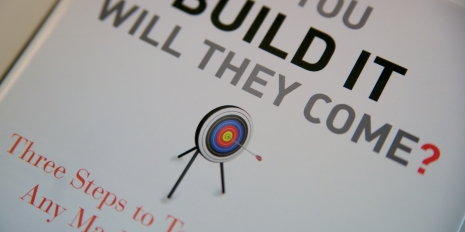
Rob Adams Market Validation Workshop.
Yesterday I attended a workshop run by Rob Adams on Market validation which was about how to go about validating market opportunities for new products and services.
Rob is strategic consultant and venture capitalist based in the US. Thanks to several New Zealand companies including IRL, the NZ Investment Fund and the Ice House, Rob was bought over to deliver a series of workshops up and down the country.
The starting position of Rob’s presentation was the fact that 90% new startup companies fail. The average product success rate he estimated to be 20-30%. His definition of a successful product is one that is still in the market 3 years after launch and is being sold. He spoke about how to better identify and validate where a market exists for your idea or opportunity.
His approach, as outlined in his book ‘If You Build It Will They Come’ published in 2010 sets out three board steps to this market validation process.
The process is stepped through as Ready, Aim and Fire.
In Ready, Rob talks about how to quickly assess and get up to speed with a market context or dynamic. Here, the critical elements include:
Rob’s main approach to carrying out this work was survey based with the work usually taking two days (which would appear an incredibly short timeframe for this type of work). He did refer to a more multi-angle approach to collecting insights that is more extended and might be more commonly used in cross-functional development teams. The approach taken at Locus Research generally incorporates a wide range of factors which could not be collected or analyzed in such a short timeframe.
In Aim, the approach is to learn what you really need to know and identify who you really need to talk to in order to really understand your audience. Here, he talks about three waves of interviews, i.e. three separate close to market and in-market primary research studies which includes:
Fire, mainly dealt with asepcts related to market entry.
What’s interesting is how to the market with possible solutions (conceptualized or non conceptualised product descriptions no more than a paragraph long) and get an initial response for each to get a feel for what may best respond to the needs of your users as in most cases any problem can be solved several ways. This is why it’s so important to start skinning up a series of possible initial ‘pitches’ and ideas based on what you believe to be your key differentiators and possible business models are, before a lot of work and development is done.
This type of approach has emerged from the design and marketing domain. We take possible new opportunities and benefits which are rapidly conceptualised for your users and customers following design research. This can gauge user preference in many cases well before an idea for a new product has even entered the full development process.
A key omission from the presentation is Empathy, something arguably responsible for the high failure rate.
Most, if not all, of our success has come from really understanding the user, and having deep empathy for their needs and situation. Surveys can give you data but spending time with people and listening and watching their behaviour can deliver greater real world insights that surveys can never really provide. If you are starting a new company and or developing a new product you have to really know and understand your users, and in most cases be (or attempt to be) your user. In the design circles this is known as ‘User Centred Design’. It positions the user at the centre of all decisions and where the development team live out either through living labs or other ways that they end up becoming the user and therefore can design products and solutions that can deliver greater benefit.
One presentation I watched recently was a talk by Dev Patnaik which he gave at the Better By Design CEO Summit in New Zealand earlier this year. Dev made a very important connection to how many of successful companies understand and validate opportunities based on empathy, and the power of empathy in the design process. Apple, Nike, Harley Davidson, let’s be honest these companies do not do conventional academic market research to validate markets, rather these companies are so in touch with their users and customers and in most cases they are the users, that they have deep empathy and know what the market wants well before anyone else, and their vision largely drives the future of these markets.
Put simply ~ a market that does not yet exist is always going to be difficult to validate, and most of the great disruptive innovations sit squarely in this space.
Comments
Post new comment